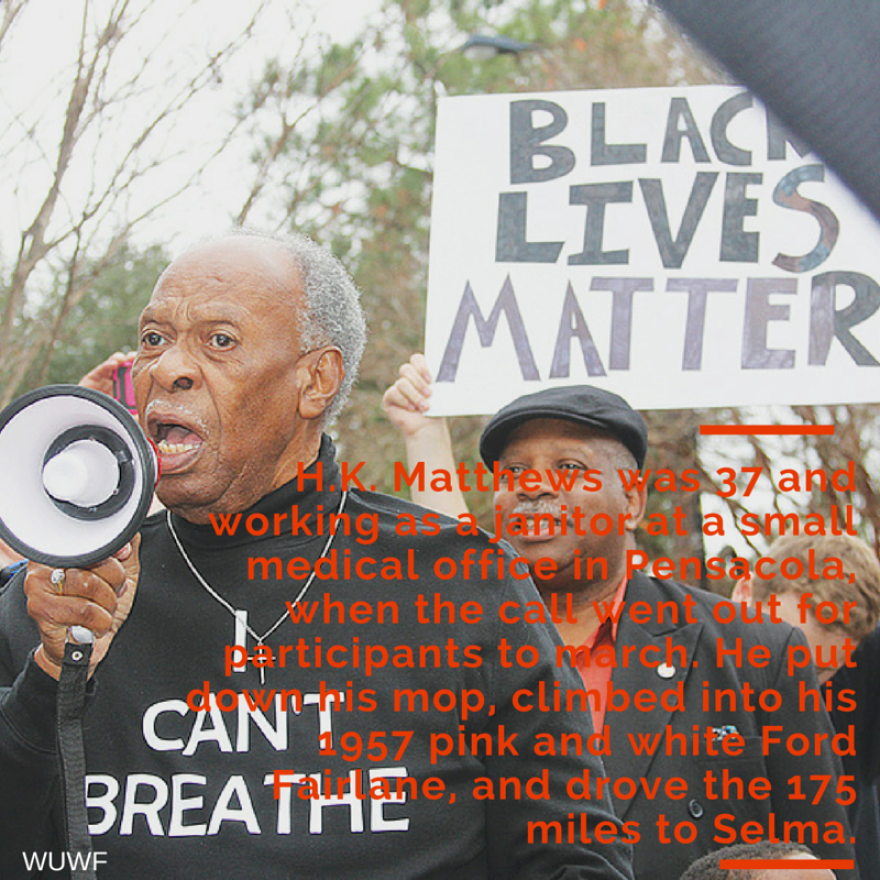You could call it a reunion of sorts. Many of those who marched at the Edmund Pettus Bridge in 1965 return to Selma this weekend for the 50th anniversary of “Bloody Sunday.” Among those is a Pensacola-area civil rights icon.
Eighty-seven-year-old Rev. H.K. Matthews was 37 and working as a janitor at a small medical office in Pensacola, when the call went out for participants to march. He put down his mop, climbed into his 1957 pink and white Ford Fairlane, and drove the 175 miles to Selma.
“I went to Selma just as a follower, I was not in a leadership role in Selma,” said Matthews. “But I was there to be in the mix, to show my support, to make myself feel as if I was a part of what was going on at that time.”
On March 7, 1965, six hundred people gathered at Brown Chapel AME Church to begin the 54-mile trek from Selma to Montgomery. Dr. Martin Luther King Jr. had an engagement in Atlanta, so Hosea Williams and future Congressman John Lewis would lead. After walking through downtown Selma without incident, things changed as they approached the Edmund Pettus Bridge.
Alabama State Troopers, in helmets and gas masks and wielding nightsticks, first stopped the marchers and then advanced into them on foot and on horseback. John Lewis and others were seriously hurt. Matthews was also among the marchers who were tear-gassed and injured.
“The most damaging blows were dealt to those who were at the front of the march, but they were just indiscriminately beating people,” Matthews said. “They didn’t ask me whether I was a leader or a follower when they started flailing. I did happen to catch a few blows.”
Thanks to the national media, the story of “Bloody Sunday” spread from coast to coast. President Lyndon B. Johnson, sensing the mood of the country, addressed Congress on national television a week later. He asked for a comprehensive voting rights bill. Lawmakers acquiesced, and Johnson signed it into law in August, 1965.
Martin Luther King called for civil rights supporters to come to Selma for a second march. Members of Congress urged him to hold off, until a court could rule if the protesters were entitled to federal protection. King led the second protest on March 9, but turned it around at the Edmund Pettus Bridge. The third march on March 21, with protection by the Alabama National Guard, was successful.
Matthews says more challenges remain in the Civil Rights movement. One of them is to make sure current and subsequent generations of Americans are educated about the struggles those pioneers endured. Movies like “Selma,” he says, can only go so far.
“We as adults and older people who were involved in the movement, and those who were not involved but who knew of about it,” said Matthews. “The failure lies with us and not our young people. Because we are not teaching our young people what happened. Most of them have no clue, no appreciation of what we went through.”
Fifty years later, another commemoration of Bloody Sunday will be held at the Edmund Pettus Bridge. Rev. H.K. Matthews will be there, along with President Barack Obama – the nation’s first African-American chief executive.


